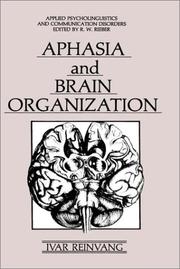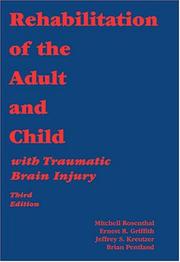| Listing 1 - 10 of 15 | << page >> |
Sort by
|
Book
Year: 2015 Publisher: New York : Springer Publishing Company,
Abstract | Keywords | Export | Availability | Bookmark
 Loading...
Loading...Choose an application
- Reference Manager
- EndNote
- RefWorks (Direct export to RefWorks)
This groundbreaking annual review has provided nearly three decades of knowledge, insight, and research on topics critical to the field of nursing. The 33rd volume delivers the most current research on traumatic brain injury (TBI) with a focus on its implications for improving health and wellbeing. The book examines promising new interventions for individuals suffering from TBI with supporting research about their efficaciousness. Invited experts--highly respected nurse scientists working in a variety of TBI-related arenas--stress outcomes and symptom development post-TBI.
Book
ISBN: 285334178X 9782853341783 Year: 1979 Publisher: Villeurbanne : Simep,
Abstract | Keywords | Export | Availability | Bookmark
 Loading...
Loading...Choose an application
- Reference Manager
- EndNote
- RefWorks (Direct export to RefWorks)
Brain --- Cerveau --- Wounds and injuries --- Complications --- Patients --- Rehabilitation --- Lésions et blessures --- Complications et séquelles --- Brain - Wounds and injuries - Complications --- Brain - Wounds and injuries - Patients - Rehabilitation

ISBN: 0306419750 1475792166 147579214X 9780306419751 Year: 1985 Publisher: New York Plenum
Abstract | Keywords | Export | Availability | Bookmark
 Loading...
Loading...Choose an application
- Reference Manager
- EndNote
- RefWorks (Direct export to RefWorks)
Neuropathology --- Aphasia --- Cognition disorders --- Brain --- Neuropsychology --- Wounds and injuries --- Complications --- Brain - Wounds and injuries - Complications
Book
ISBN: 0140805796 9780140805796 Year: 1975 Publisher: Harmondsworth Penguin books
Abstract | Keywords | Export | Availability | Bookmark
 Loading...
Loading...Choose an application
- Reference Manager
- EndNote
- RefWorks (Direct export to RefWorks)
#KVHB:Afasie --- #KVHB:Hersenbeschadiging --- Brain --- Brain damage --- Wounds and injuries --- Brain - Wounds and injuries
Book
ISBN: 1461419743 9786613445667 1283445662 1461419751 Year: 2012 Publisher: New York : Springer,
Abstract | Keywords | Export | Availability | Bookmark
 Loading...
Loading...Choose an application
- Reference Manager
- EndNote
- RefWorks (Direct export to RefWorks)
Planners, timers, and similar items have long been used to compensate for cognitive deficits after the brain recovers from injury or illness. Although such tools can be effective, they limit patients’ use of their own resources in their recovery. By contrast, cognitive remediation offers an alternative by using the brain’s intact structures in making up deficits, giving patients a greater sense of control than reliance on outside devices. Cognitive Remediation for Brain Injury and Neurological Illness brings this modality into clear focus, providing both up-to-date data and a highly useful framework for treatment planning and intervention. This instructive volume explains the mechanisms behind cognitive remediation and makes the empirical case for its clinical use. Readers are taken through each stage of assessment and treatment, demonstrated by the innovative computer-based NeurXercise program, and a series of in-depth case examples shows the interventions in action. Concise and practical, Cognitive Remediation for Brain Injury and Neurological Illness charts new paths toward patient recovery for neuropsychologists, health psychologists, and rehabilitation specialists.
Brain -- Wounds and injuries -- Patients -- Rehabilitation. --- Brain -- Wounds and injuries. --- Brain --- Craniocerebral Trauma --- Brain Diseases --- Therapeutics --- Behavior Therapy --- Wounds and Injuries --- Psychotherapy --- Trauma, Nervous System --- Central Nervous System Diseases --- Analytical, Diagnostic and Therapeutic Techniques and Equipment --- Nervous System Diseases --- Diseases --- Behavioral Disciplines and Activities --- Psychiatry and Psychology --- Brain Injuries --- Rehabilitation --- Cognitive Therapy --- Human Anatomy & Physiology --- Medicine --- Health & Biological Sciences --- Neurology --- Neuroscience --- Patients --- Wounds and injuries --- Treatment. --- Wounds and injuries. --- Cerebrum --- Mind --- Psychology. --- Geriatrics. --- Rehabilitation. --- Health psychology. --- Neuropsychology. --- Health Psychology. --- Geriatrics/Gerontology. --- Central nervous system --- Head
Book
ISBN: 9782714444080 2714444083 Year: 2008 Publisher: Paris: Belfond,
Abstract | Keywords | Export | Availability | Bookmark
 Loading...
Loading...Choose an application
- Reference Manager
- EndNote
- RefWorks (Direct export to RefWorks)
Neuroplasticity --- Brain damage --- Brain wounds and injuries --- Plasticité neuronale --- Personnes atteintes de lésions cérébrales --- Cerveau --- Patients --- Rehabilitation --- Treatment --- Réadaptation --- Lésions et blessures --- Traitement --- Plasticité neuronale --- Personnes atteintes de lésions cérébrales --- Réadaptation --- Lésions et blessures --- Brain damage - Patients - Rehabilitation
Book
ISBN: 370910355X 9786613087799 3709103568 1283087790 3709116597 Year: 2010 Publisher: Wien : Springer,
Abstract | Keywords | Export | Availability | Bookmark
 Loading...
Loading...Choose an application
- Reference Manager
- EndNote
- RefWorks (Direct export to RefWorks)
More than 40 articles provide an extensive coverage of advances over the last three years of research on clinical management of subarachnoid hemorrhage. Novel experimental treatment strategies for early brain injury and cerebral vasospasm targeting genetic, molecular, and protein signaling pathways in preclinical models; surgical and endovascular treatment promote collaborative efforts from neurosurgery, neurology, radiology and neuro-ICU; advancement of neuroimaging provides guidance for new treatment strategies to reduce early brain injury and attenuate cerebral vasospasm.
Brain -- Wounds and injuries. --- Brain. --- Cerebrovascular spasm. --- Surgery & Anesthesiology --- Health & Biological Sciences --- Surgery - General and By Type --- Cerebrovascular spasm --- Brain --- Neurology --- Treatment. --- Wounds and injuries --- Cerebral vasospasm --- Vasospasm, Cerebral --- Medicine. --- Neurosurgery. --- Medicine & Public Health. --- Cerebrum --- Mind --- Central nervous system --- Head --- Cerebrovascular disease --- Spasms --- Nerves --- Neurosurgery --- Surgery --- Nervous system --- Surgery.

ISBN: 0803603916 9780803603912 Year: 1998 Publisher: Philadelphia F.A. Davis Company
Abstract | Keywords | Export | Availability | Bookmark
 Loading...
Loading...Choose an application
- Reference Manager
- EndNote
- RefWorks (Direct export to RefWorks)
Brain Injuries --- Brain --- Brain-damaged children --- rehabilitation --- Wounds and injuries --- Patients --- Rehabilitation --- Rehabilitatie --- Traumatologie --- Adolescenten --- Kinderen --- Adolescent --- Kind --- Jeugd --- Media --- Ontwikkelingsstoornis --- Fysiotherapie --- Adulte --- Enfant --- Médecine physique et de réadaptation --- Traumatismes cranioencéphaliques --- Brain Injuries - rehabilitation --- Brain - Wounds and injuries - Patients - Rehabilitation --- Brain-damaged children - Rehabilitation --- Cerebro-lese
Book
ISBN: 3709111919 3709117399 9786613925145 3709111927 1283612690 Year: 2013 Publisher: Vienna ; New York : Springer,
Abstract | Keywords | Export | Availability | Bookmark
 Loading...
Loading...Choose an application
- Reference Manager
- EndNote
- RefWorks (Direct export to RefWorks)
The book contains 48 articles presented at the 11th International Conference on Cerebral Vasospasm held in Cincinnati, Ohio, USA, in July 2011. This collection of papers represents a cross-section of the enormous progress that has been made towards a thorough understanding and effective treatment of neurovascular events following aneurysmal subarachnoid hemorrhage, including cerebral vasospasm. It is of interest to clinicians who wish to apply state-of-the-art knowledge to their management of this devastating condition and to basic scientists wishing to expand their understanding of cerebrovascular and neural pathophysiology related to subarachnoid hemorrhage.
Brain -- Wounds and injuries. --- Cerebrovascular spasm. --- Vasospasm, Intracranial. --- Cerebrovascular spasm --- Subarachnoid hemorrhage --- Cerebrovascular Disorders --- Intracranial Hemorrhages --- Hemorrhage --- Vascular Diseases --- Brain Diseases --- Central Nervous System Diseases --- Cardiovascular Diseases --- Pathologic Processes --- Diseases --- Nervous System Diseases --- Pathological Conditions, Signs and Symptoms --- Vasospasm, Intracranial --- Subarachnoid Hemorrhage --- Medicine --- Surgery & Anesthesiology --- Health & Biological Sciences --- Neurology --- Surgery - General and By Type --- Cerebral vasospasm --- Vasospasm, Cerebral --- Medicine. --- Neurosurgery. --- Medicine & Public Health. --- Cerebrovascular disease --- Spasms --- Brain --- Spinal cord --- Intracranial aneurysms --- Rupture --- Nerves --- Neurosurgery --- Surgery --- Nervous system --- Surgery.
Book
ISBN: 1607619644 9786612971327 1607619652 1282971328 Year: 2010 Publisher: New York : Springer Science+Business Media, LLC,
Abstract | Keywords | Export | Availability | Bookmark
 Loading...
Loading...Choose an application
- Reference Manager
- EndNote
- RefWorks (Direct export to RefWorks)
There are currently no reparative therapies for severe neurological injury, including brain injury, spinal cord injury and stroke. Actually, most treatments are designed simply to limit secondary damage. However, pre-clinical data supports the idea that exogenous stem and progenitor cells have the potential to promote a reparative response to severe neurological injuries. Progenitor Cell Therapy for Neurological Injury is a compilation of seminal essays that explore many unique aspects of neurological injury, focusing on the critical translational issues of cell delivery. Specifically, it discusses routes of administration, types of progenitor cells (alone and/or in combinations), timing of delivery and adjuncts to promote cell engraftment, survival and effectiveness. In addition, many chapters address measuring the effects of transplanted cells and cell tracking. The paradigms of how cell-based therapeutics affect neurological injury is changing rapidly. The developments in this field may ultimately offer realistic hope for improvement in patients with severe injuries. This book is a vital key toward unlocking those future treatments.
Brain -- Wounds and injuries -- Treatment. --- Medicine. --- Stem cells -- Therapeutic use. --- Stem cells --- Brain --- Cell Transplantation --- Diseases --- Transplantation --- Nervous System Diseases --- Stem Cell Transplantation --- Surgical Procedures, Operative --- Analytical, Diagnostic and Therapeutic Techniques and Equipment --- Biology --- Health & Biological Sciences --- Cytology --- Pharmacy, Therapeutics, & Pharmacology --- Therapeutic use --- Wounds and injuries --- Treatment --- Cellular therapy. --- Nervous system --- Cell therapy --- Cells --- Therapy, Cellular --- Treatment. --- Life sciences. --- Stem cells. --- Life Sciences. --- Stem Cells. --- Organotherapy --- Therapeutics, Physiological --- Transplantation of organs, tissues, etc. --- Cell transplantation --- Colony-forming units (Cells) --- Mother cells --- Progenitor cells
| Listing 1 - 10 of 15 | << page >> |
Sort by
|

 Search
Search Feedback
Feedback About UniCat
About UniCat  Help
Help News
News